
RENÉ CHARTRAND, ILLUSTRATED BY RON VOLSTAD
CANADIAN FORCES IN WORLD WAR II
The Commonwealth air training programme

Canadian Army winter cap for enlisted men issued to troops in Canada. It was fairly high- crowned, with the side flaps usually worn tied up with a thin ribbon across the top. Its front flap was permanently turned up and the unit badge was often pinned to the centre - of Plate A2. (Ed Storey Collection)

The officer's winter cap issued for service in Canada was of khaki woollen cloth but with front and side flaps faced with brown fur. (Ed Storey Collection)
As soon as war was declared thousands of volunteers signed up to join the RCAF; some even went directly to England to join the RAF. The small RCAF was immediately overwhelmed: it needed vast numbers of new- aircraft, new airfields and, most of all, trained aircrews. The British RAF also urgently needed trained aircrews; and on 17 December 1939 the British Commonwealth Air Training Plan (BCATP) was created. This called for a huge training programme for aircrews to be established in die vast - and safe - air space of Canada; outright, Canada became the largest flying school in the world. By 1941 there were 30 Elementary Flying Schools, 29 Elementary Flying Training Schools, 11 Bombing 8c Gunnery Schools, ten Air Observer Schools, seven Operational Training Schools, six Air Navigation Schools, four Wireless Schools, three Flying Instructor Schools, one Naval Air Gunners School and one Flight Engineers School. All this was organised in Training Commands numbered 1 to 4.
Aircraft were found in Britain and the USA, but in this as in so many other cases the home industry also rose to the national need. Initially tiny, the Canadian aircraft industry grew by leaps and bounds; old Finch and Fairev Battle aircraft were soon joined by numbers of Tiger Moth and Harvard trainers. Training was given by Canadian, British and American instructors; as many were civilians, they were often grouped in para-military organisations. SuFFIce it to say that, from its inception until 31 March 1945, so me 131,553 aircrew graduated from the BCATP. Of these 73,000 were Canadians; 42,000 from the RAF (including airmen from various British territories as well as Free French, Belgians, Poles, Norwegians, Dutch, etc.); 10,000 from Australia, and 7,000 from New Zealand. This was an impressive total when one considers that 288,000 aircrew were trained in the USA, whose population and resources were ten times those of Canada.
The RCAF also had to expand quickly to meet the demands for home defence and squadrons sent overseas. The Home Air Force in Canada initially concentrated in a few squadrons, all scrambling to get some aircraft - notably flying boats and bombers. With U-boats lurking along the Canadian coastline targeting ship convoys going to Britain, the emphasis fell on the Atlantic provinces and Newfoundland in 1939 and 1940; the west coast was all but undefended, with only a handful of elderly aircraft.
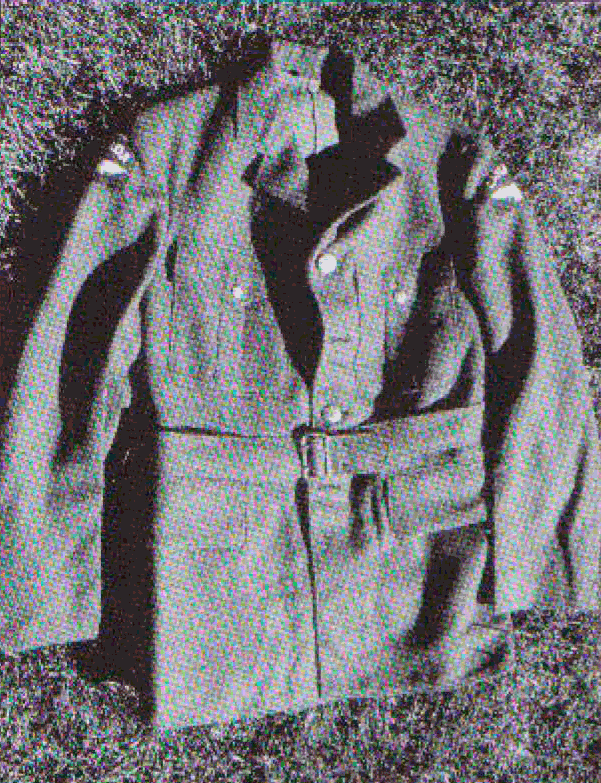
1936 RCAF enlisted ranks' blue-grey service jacket with white metal buttons. The blue-black shoulder title with 'CANADA' in an arc over the eagle, both in white, shows that this garment was worn overseas This example was made in Montreal by the T.Eaton Co. in 1942. (Ed Storey Collection)
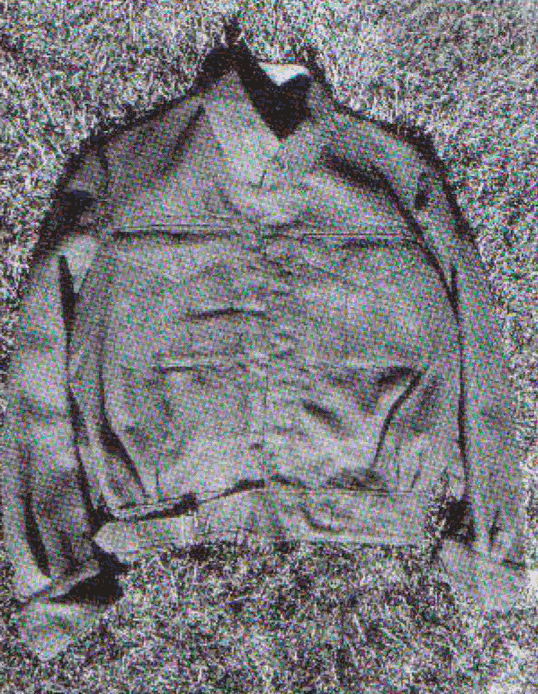
In 1940 a blue-grey blouse and trousers modelled on the khaki Battledress was introduced in 1940 as the 'Suit, Aircrew' - redesignated 'War Service Dress' in October 1943. It was not to be worn for parades and was of the same quality for all ranks. A feature of the trousers was that the left thigh 'map' pocket was much smaller than on Army BD trousers. (Ed Storey Collection)
The Japanese offensive of December 1941 naturally increased the urgency of organising some defence for the west coast. From June 1942 British Columbians became seriously worried about Japanese air attacks when, in the Aleutians, Dutch Harbor was bombed and the islands of Kiska and Attn were occupied by Japanese troops. Politicians bowed to public pressure, and scores of modern aircraft were quickly sent to the west coast. With hindsight this may be judged a highly successful Japanese diversion: eventually a total of 36 RCAF squadrons were based on the Pacific coast which, as Japan's naval air resources declined sharply after the battle of Midway, saw virtually no action. (There was one encounter, when an RCAF Bolingbroke - the Canadian version of the British Blenheim bomber - sank a Japanese submarine off the coast of British Columbia in July 1942.)
In spring 1943 the Allies were at last successfully turning the tide in the Battle of the Atlantic against Germany's U-boats, and RCAF squadrons - notably those now flying B-24 Liberators - made a significant contribution to 'closing the mid-Atlantic gap'. As time passed and the possibility of serious enemy attacks practically vanished, so the Home Air Force shrank, and many squadrons were transferred overseas or disbanded. By September 1945 there remained only 17 RCAF squadrons in Canada.
The first RCAF unit overseas was No. 110 Squadron with its Lysander scout planes, which arrived in England in late February 1940, followed by No.1 Sqn with its Hurricanes, and many others in August and September 1940. With more RCAF squadrons on the way to Britain from Canada and elsewhere, a new squadron numbering sequence was introduced by the RAF in March 1941 in order to avoid confusion. Canada got the 4400' series, which expanded rapidly from its initial four squadrons. In the meantime, the RAF's No.242 all Canadian* squadron had been formed in Britain during October 1939 from Canadians volunteering directly into the RAF. Badly mauled in the closing stage of the Battle of France, No.242's Hurricane pilots quickly recovered their edge under the leadership of the legless RAF ace Douglas Bader; based at Coltishall, they fought effectively in the Battle of Britain under command of No.12 Group.
The Canadian government eventually wished for a more distinct RCAF identity, since some 60 per cent of Canadian flyers were serving in RAF units and a quarter of Bomber Command was formed by RCAF personnel, notably 6 Group. Thus, in time, some RAF units became Canadian. However, senior operational command devolved to the RAF which effectively controlled the Canadian squadrons overseas. As time passed the RCAF squadrons became quite mixed, much like many other RAF units. The RCAF unit ground crews were mainly British, and some pilots of British or other nationalities could be found on the squadrons.
Whatever the politics, it was an effective combination. By late 1944, 43 RCAF squdrons were serving overseas including 19 day fighter and fighter-bomber, three night-fighter and 15 bomber squadrons. The RCAF were credited with downing some 1,200 enemy aircraft; and the top Canadian aces in the RAF were credited with another 119. The RCAF's 6 Group of bomber squadrons made nearly 41,000 sorties, dropping over 126,000 tons of bombs, though at a cost of 814 planes.
From 1924 the uniforms and equipment of the RCAF were very similar to those of the RAF. (For details, see Cormack, Select Bibliography.) The RCAF pilot's wings badge worn on the left breast was similar to that of the RAF except that the letter 'C' surrounded the 'A' in early versions and circled all letters in later versions. The other badges usually had 'RCAF' in small letters below the trade's crowned letter, except for the observer's 'O' which was plain.
The basic identification for Canadian airmen serving overseas was a white title 'Canada' on a blue-black shoulder flash, plain for officers and below the RAF's white eagle badge for enlisted men. (The title and badge were red on the tropical khaki uniform.) On 17 May 1940, personnel in Canada were 'absolutely prohibited' from wearing the national tide while in the country. It was allowed for RCAF personnel serving in Newfoundland on 5 September 1941.
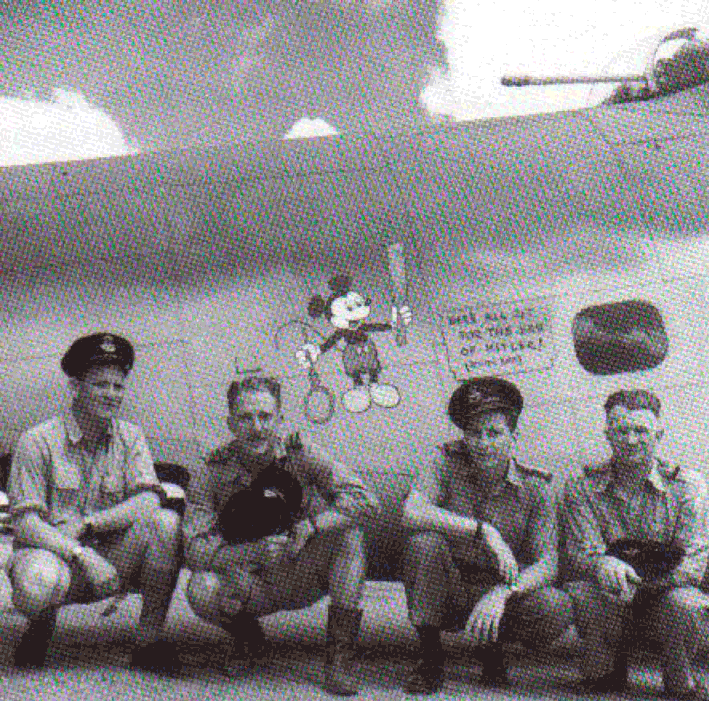
Royal Air Force Ferry Command aircrew in Trinidad, West Indies, in front of a Lockheed Vega bomber, October 1943. Besides the main North Atlantic route some aircraft were ferried via Nassau (Bahamas), Trinidad, and Senegal (French West Africa) to North Africa. The summer light khaki shirtsleeve uniform is worn with the distinctive dark blue Ferry Command cap. (National Archives of Canada, PA114613)
In early 1941, bizarrely, the wearing of scarves was forbidden for RGAF personnel when flying, but this order was widely ignored. On 30 May 1941, Americans in the RCAF were allowed a 'U.S.A.' shoulder title when serving in Canada, and when overseas a title with 'Canada' above 'U.S.A.'; this order was cancelled in 1943 (DND, RCAF Routine Orders 1940-1943).
Khaki drill summer uniforms were ordered discontinued from August 1941 for all RCAF commands, but this rather impractical order was cancelled in 1943. The RCAF issue consisted of the KD bush jacket and trousers to be worn with blue-grey caps. There was no RCAF issue of tropical sun helmets, shorts and stockings as there was in the RAF, but the few Canadian squadrons serving in the Middle East and Far East received RAF tropical issues. Ralph Palmer, who served with No.420 Sqn in Algeria, recalled that 'pith helmets, shirts and shorts were the usual attire' in early 1943.
Winter clothing consisted of double-breasted greatcoats, overshoes, gloves, fur caps for officers and cloth caps for enlisted men. The pattern and cut of the greatcoats and caps were the same as for the Army but made from RCAF blue-grey cloth, with RCAF titles, badges and buttons. The fur and cloth caps were only worn in North America.
The BCATP trainees wore their respective nations' air force uniforms. From 18 July 1941 the false turned-up peak visible at the front of the field service cap became white for aircrew under training; this was removed after graduation. Between July 1941 and February 1942, white armlets were issued to graduates until they could obtain officers' uniforms. The civilian personnel of BCATP instruction schools wore dark blue uniforms of approximately the same cut as the RCAF with distinctive brass buttons, cap badges and pilots' wings; these usually bore the letters 'EFS' (Elementary Flying School), 'EFTS' (Elementary Flying Training School) or 'AOS' (Air Observer School), Women instructors had dark blue jackets and skirts with white 'ETFS' titles on dark blue shoulder flashes, and pale blue or white open-collar blouses.
During 1940, when Britain was desperate for aircraft of all types and U-boats were sinking over half of those shipped from North America, a scheme to fly the larger planes across the North Atlantic was approved by Prime Minister Churchill and the Canadian authorities. Regular air crossings had been deemed impossible, especially in winter, and far too costly; but these were desperate times - if more than half of the aircraft sent over made it to Britain, it was worth the gamble.
The RAF would direct these operations with a few senior officers in Montreal, where Dorval airfield was built. Aircrews and support personnel would be mostly civilians. Airline pilots from Canada and Britain, Canadian 'bush' pilots and American pilots thus joined ATFERO (Atlantic Ferry Organisation) from the autumn of 1940, becoming 'Ferry Command' on 20July 1941. Ground security personnel were uniformed, armed, and assumed duties as varied as trying to save aircrew from burning crashed planes to providing part of Churchill's 'British' security guards at the Quebec Conferences. In March 1943, Ferry Command became No.45 Group in the new RAF Transport Command. Over 10,000 men served in this organisation during the war, and it flew some 10,000 aircraft to Europe.
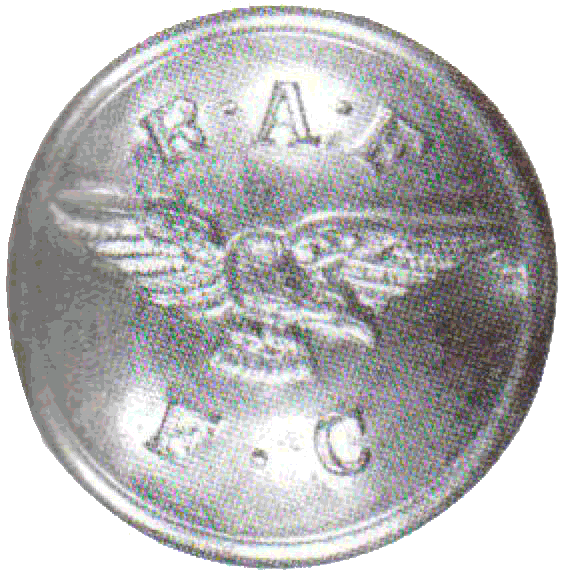
IAF Ferry Command brass button, 1940-45. This RAF organisation based in Canada, which evolved from the Atlantic Ferry Organisation of civilian pilots, had distinct buttons for its dark blue RAF-style uniforms. Private collection)
Initially, ATFERO's non-RAF personnel had no uniforms, and this raised concern over their fate should they be forced down in enemy territory. Anything that looked like a uniform was initially worn, with personnel from airlines such as Imperial Airways or Trans-Canada Airlines (now British Airways and Air Canada respectively) wearing their dark blue uniforms. In the early summer of 1941, Air Cdre.G.J. 'Taffy' Powell 'put them all in service-style khaki with caps', and a badge was hastily designed in his Dorval airfield office; this featured a lion astride the Northern Hemisphere. Few of these badges were made up, as from mid-summer 1941, we were on firmer ground for insignia generally', recalled Powell. We fell heir to the standard RAF eagle and the astral crown. These were incorporated in cap badges, wings and half-wings, which were worn with chrome buttons on dark blue winter uniforms and khaki in summer. Standard RAF-type stripes were used for senior captains, co-pilots and other aircrew. From then on we were reasonably sure of officer status being given to those who got into strange situations or became prisoners of war.'
Ground security personnel were also dressed in the dark blue RAF-style uniforms and had RAF rank insignia for NCOs. The buttons were distinctive, having no astral crown but bearing 'F.C.' They were used until the end of the war, as were the dark blue uniforms, long after Ferry Command had become RAF Air Transport Command.
Formed in 1910, the Royal Canadian Navy (RCN) had a permanent component supported by a Reserve. It was patterned very closely on Britain's Royal Navy in organisation and equipment. In 1923 the Royal Canadian Naval Reserve and Royal Canadian Naval Volunteer Reserve were formed as distinct organisations, which were to prove invaluable in the coming conflict. In September 1939, Canada had only six destroyers, five minesweepers and two training vessels, manned by 1,365 officers and men, with the reserves adding another 1,800. From these the Canadian fleet grew to 363 craft of all sorts, making it, by the end of 1945, the third largest Allied navy after the USA and Britain, with a total during the war years of 118 corvettes, 60 frigates, 15 destroyers, 12 other escorts, three armed merchant cruisers, two cruisers and two escort carriers, plus numerous minor craft. Bv VJ-Dav, 89,000 men and 6,700 women had enlisted in its service.
During World War II the RCN concentrated mostly on the difficult but vital mission of escorting convoys in the North Atlantic. Small escort vessels, notably corvettes, coped with an unpredictable climate including fog, heavy seas and winter ice, as well as German U-boats. In 1942, U-boats penetrated the Gulf of St Lawrence and sank 22 vessels, some of them within sight of coastal towns.
Tasked with vastly greater responsibilities than either the Canadian or the British naval staffs had anticipated, the RCN expanded to sixty times its pre-war strength between 1939 and 1945. At first undertrained and underequipped, Canadian warships managed to destroy 33 enemy submarines by the end of the war: one each in 1940 and 1941, six in 1942. seven in 1943, and 18 in the last 18 months of the war against Germany. In spite of some setbacks, the small RCN ships safely escorted about 25,000 merchant ships bearing 180 million tons of cargo from North America to Britain.
On D-Day, 109 RGN ships manned by 10,000 sailors were part of the Normandy invasion fleet for Operation 'Neptune', and ferried some 45,000 soldiers to the beaches. In response to British requests for help in manning ships, the RGN acquired two light cruisers and provided crews for two auxiliary aircraft carriers in 1943-44, with plans for greater participation in the war against Japan. However, only one cruiser took part in operations in the Pacific before VJ-Day.
Initially, RCN uniforms were very similar to those of the Royal Navy (see Plate G; and Sumner, Elite 79, Select Bibliography). The British dress regulations were followed in minute detail, and indeed, most pre-war Regular officers bought their uniforms from Gieves, the naval outfitters in London, when they took their initial training with the Royal Navy. The only difference was the small 'Canada' on the gilt button between the crown and the anchor for officers with the rank of commodore and below. Chief Petty Officers had only the crown and anchor. Leading rates and below had black horn buttons with 'Canada' between the crown and the anchor. Sailors wore the yellow- gold 'H.M.C.S.' (His Majesty's Canadian Ship) followed by the ship's name on the black cap ribbon, with a uniform otherwise identical to the Royal Navy's. After September 1939 die ribbon officially bore only 'H.M.C.S.'.
The enlistment of tens of thousands of volunteers brought a new spirit and a call for more Canadian identity on the uniform, as in the other services. Yellow-on-dark blue 'Canada' shoulder tides were added in 1941, although at first somewhat resented by old-timers. Again following an unofficial RN fashion, by 1942 some ratings were seen with ribbons bearing e.g. 'H.M.C. DESTROYERS' or 'H.M.C. MINESWEEPERS', etc; this practice was immediately forbidden, and an order of 15 May 1942 confirmed the 'H.M.C.S.' tally as the only pattern allowed.
There were occasional variations in the uniform. From September 1939, the seamen's white jumpers and trousers traditionally made of British duck flax material were made of cotton, a material available in quantity in Canada. In February 1941, gold silk lace was authorised for officers' rank rings because of the scarcity of metallic gold lace.
For all, hair was cut short and moustaches not allowed, but 'permission to discontinue shaving' was occasional)' granted to crew members by captains - as long as the resulting 'full set' of beard and moustache was suitably virile and neatly trimmed.
Officers belonging to the RCNVR had the same dress as the RCN but, according to regulations, 'instead of each distinctive stripe of gold lace round the sleeves of the coat there is a waved line of three-eighths inch gold lace. (The half stripe, however, is a straight line of one-eighth inch gold lace.)'. As in the British service, this special rank lace earned the RCNVR the nickname of 'Wavy Navy'. The coloured edges of nonexecutive officers followed the curves of the lace. In February 1941, only the curl on the sleeve, the same size as on shoulder straps, was allowed due to the scarcity of lace at that time. RCNVR Midshipmen had maroon collar tabs and twist cord instead of white. Ratings wore identical uniforms to the RCN, initially with 'R.C.N.V.R.' cap ribbons from 1938, but later the 'H.M.C.S.' ribbon was worn. Royal Canadian Fleet Reserve officers had their rank lace narrow and intertwined. The ratings wore identical uniforms to the RCN, with 4Royal Canadian Fleet Reserve' cap ribbons from 1 April 1939 but later with the 'H.M.C.S' ribbon.
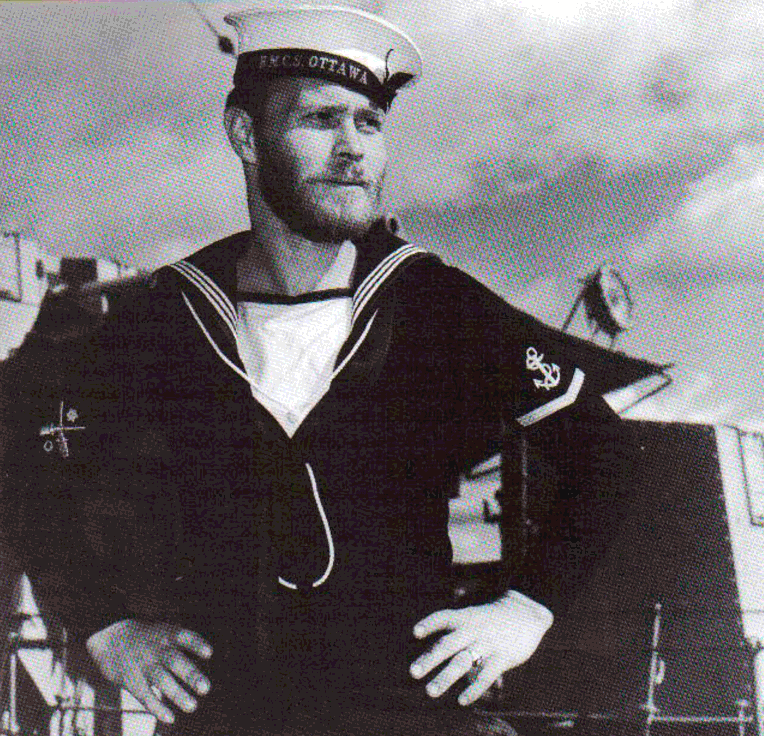
Leading Seaman Brown, of the destroyer HMCS Ottawa, at Halifax in summer 1940. He wears the white-topped cap with No.1 Dress - blue jumper with badges in gold rather than red, bell-bottoms, blue-edged white front', collar, black silk neckerchief and white lanyard. The anchor and chevron on his left sleeve indicates his rate and three years of good conduct. On his right sleeve the star, crossed guns and 'Q' indicate a 2nd Class Gunnery Rating for Quarters. At this date the full ship's name was still worn on the cap tally by crews of the few pre-1939 ships to mark them out from the Hostilities Only ratings already rearing the universal 'H.M.C.S.' ribbon. This HMCS Ottawa was ost on 13 September 1942, but a new River Class destroyer took up the name in 1943. (National Archives of Canada, PA104373)
There was also, from early 1942 until April 1943 on the Pacific Coast, a small 'Fishermen's Reserve' for service in local waters. Made up of about 191 fishermen manning 21 vessels, they were very active, largely in going into the bays and inlets of British Columbia to make sure Japanese ships were not hiding in them. It was initially assumed that the reservists would want to wear civilian clothes, but they requested uniforms so that they would be identified with the navy. A uniform of sorts evolved: officers wore a seaman's jersey and bell-bottom trousers with an officer's cap, and seamen wore uncollared jerseys with bell-bottoms. Often, however, the fishermen resorted to their more familiar civilian working rig of Cowichan sweaters, trousers and gumboots; as a result they were informally referred to as 'the gumboot navy'. Seventy-three went on to serve in the RCNVR as landing craft crews.
We have much more interesting information on this site.
Click MENU to check it out!
∎ cartalana.com© 2009-2025 ∎ mailto: cartalana@cartalana.com